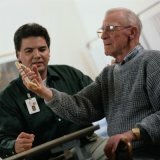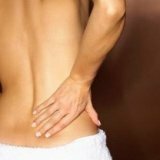Trigeminal neuralgia: signs and symptoms, treatment
Neuralgia of the facial nerve or trigeminal neuralgia is a serious disease accompanied by acute, paroxysmal pain in the area of its junction. It can occur due to existing diseases, hypothermia, infections.
Trigeminal neuralgia causes severe facial pain. Although pain attacks last only a few seconds, they are some of the most severe pain pains known in the history of medicine.
In this article we will tell you how treat neuralgia trigeminal nerve and what are the consequences of untimely therapy.
Content
- What is trigeminal neuralgia?
- How common is trigeminal neuralgia?
- Classification (types of trigeminal neuralgia)
- Causes of occurrence
- Symptoms of trigeminal neuralgia
- Complications
- Diagnostics
- Treatment of trigeminal neuralgia
- Drug treatment
- Anticonvulsants
- Muscle relaxants
- Pain relievers
- Vitamins of group B
- Additional drugs used for trigeminal neuralgia
- Surgery
- Folk remedies
- Prevention and recommendations for patients
- Forecast
What is trigeminal neuralgia?
Neuralgia of the facial nerve (trigeminal neuralgia) is a chronic severe pain associated with cramps of the facial nerve, in 90% of cases occurring in people over 40 years of age.
In this case, inflammation of the trigeminal nerve occurs, the patient complains of severe attacks of pain, similar to a lumbago, electric shock or burning sensation on one side of the face, less often on two. The attack itself lasts up to 2 minutes, their number per day can reach 200. At night, attacks are practically not observed.
The symptom occurs when the trigger zones are irritated by various factors (while shaving, brushing your teeth or washing your face), chronic infectious processes and diseases.
In most cases it covers the 3rd and 2nd branch of the trigeminal nerve, less often - the first or three at once. The first branch provides sensitivity to the frontal part, the second - the upper lip, gums, cheeks and nostrils, the third - the lips, gums and lower jaw.
Exacerbation of facial neuralgia often occurs in winter, less often when exposed to drafts in summer.
How common is trigeminal neuralgia?
Typically, trigeminal neuralgia is the classic form of the disease. It occurs especially after 40-50 years. On average, 4 to 6 out of 100,000 people suffer from the disease, women are slightly more likely than men (ratio 1.5: 1).
Classification (types of trigeminal neuralgia)
There are several classifications of the disease.
Facial neuralgia is of two types:
- true form - arises as an independent symptom due to interruptions in the blood supply to the nerve or its compression;
- secondary form of facial neuritis - provoked by an existing disease: multiple sclerosis and vascular pathology, disturbed endocrine and metabolic processes, herpes and shingles. It can also be caused by serious infections and neoplastic processes.
In 20% of cases, the disease affects the first branch. Basically, the 2nd and 3rd branches are inflamed, sometimes - several branches of the trigeminal nerve. In this case, there is an increased sensitivity and soreness of the affected area, or its loss of sensitivity. There are times when a part of the face loses its mobility and "sags".
Causes of occurrence
Inflammation of the trigeminal nerve can be caused by various factors:
- compression of the nerve by vessels, displaced arteries and veins;
- disturbed metabolism and diseases associated with this: endocrine pathologies, diabetes, gout;
- hypothermia of the facial nerve;
- infections in the facial area in a chronic form (caries, sinusitis);
- inflammatory processes resulting from poor-quality filling or tooth extraction,abscess gums, pulpitis;
- viral and infectious diseases (herpes, shingles, syphilis, pulmonary tuberculosis);
- mental disorders;
- purulent diseases of the bones of the skull, jaws;
- advanced allergies;
- damage to the body with worms (helminthic invasion);
- atherosclerosis;
- brain tumors (gliosis, cancer, etc.).
An exacerbation of the disease, with a history of facial neuralgia of the trigeminal nerve, can occur due to the effect of an irritating factor on it. Irritants include shaving for men and brushing teeth, stroking the face with a napkin, hand or handkerchief.
Also, neuralgia of the facial nerve can occur during the process of eating and drinking, applying makeup, with emotions (crying, laughing, smiling) and exposure to pungent odors (ammonia, cologne, acetone).
Read also:Multiple sclerosis: causes and symptoms
Symptoms of trigeminal neuralgia

In most cases, there is a right-sided inflammation of the trigeminal nerve, and patients in 90% of cases are persons after 40 years, mostly female.
The disease is characterized by cyclicality: exacerbation is replaced by remission. The most frequent time for acute attacks of pain occurs in autumn and spring.
The main symptoms of trigeminal neuralgia are acute, paroxysmal pain resembles an electric discharge in character, lumbago or burning. It lasts from 10 seconds to several minutes, then passes. The number of attacks per day can reach 200. The person has the feeling that pain covers the ears, nose, eyes and the whole head, muscles can twitch violently;
In the chronic form of the disease, the localization of the pain syndrome remains unchanged for many years. It may irritate the auditory and facial nerves.
To alleviate the symptom, patients make chewing movements, while they are practically immobilized, there is no crying or screaming.
Against the background of facial neuritis phobia develops and increased anxiety - a person subconsciously avoids postures, movements and factors provoking an exacerbation of the disease. During illness, a person tries to chew on the side opposite to the painful half when eating and drinking. There are frequent cases of neuropathic complications and secondary pain symptoms in the head.
If the inflammation of the trigeminal nerve is not treated in time, dystrophy of the masticatory muscles and a decrease in the sensitivity of the affected area are possible.
Complications
When the condition is neglected, serious consequences can occur: damage to the nervous system, prolonged pain syndrome, violation of facial symmetry, paralysis and paresis (decreased muscle strength) of the muscles of the face, hearing impairment, twitching eyes.
Inflammation of several branches of the trigeminal nerve leads to the occurrence of periodic pain attacks triggered by hypothermia and other factors. This certainly affects the patient's quality of life.
Diagnostics
Before trigeminal inflammation can be treated, it must be diagnosed and separated from other possible diseases. Neuralgia symptoms are similar to frontal, dental pathology, otitis and sinusitis.
To do this, at a consultation, a neurologist conducts an initial examination, listens to complaints and identifies possible symptoms. MRI (magnetic resonance imaging) is done to determine the cause of the disease. This allows you to see the structure of the nerves, the existing pathologies of blood vessels and tumors, their localization, if any.
Diagnostic methods include the following procedures:
- consultation with a dentistto identify possible dental diseases, poor-quality filling or removal, unsuccessful prosthetics;
- X-ray of the skull and teeth lets see pinched facial nerve and the entities that did it;
- to determine the nature of the passage of impulses along the nerve, electromyography;
- to exclude the viruses that caused the disease, the patient needs take a blood test.
Treatment of trigeminal neuralgia
Treatment of trigeminal neuralgia at home includes taking medications prescribed by a neuropathologist, physiotherapy, and in difficult cases, surgery. Correctly selected medicines can get rid of pain syndrome and improve the patient's quality of life.
Drug treatment
The choice of drugs, dosage and duration of their use is strictly carried out by a neurologist. The main groups for therapy are anticonvulsants, muscle relaxants and antispasmodics, non-steroidal anti-inflammatory drugs (NSAIDs).
Anticonvulsants

Finlepsin with trigeminal neuralgia - the most prescribed and effective imported (Germany or Poland) drug with an anticonvulsant effect. Finlepsin's action is based on carbamazepine.
The medicine relieves pain and possible cramps, muscle twitching. The dosage is prescribed depending on the patient's weight, age and concomitant diseases. The effect of taking pills comes within 8 hours. If for any reason you have not taken a pill, you cannot take a double dose.
The drug is used in large dosages until the pain completely disappears, and then maintenance therapy is carried out for some more time. It influences the cause of the disease and the inflammation of the trigeminal nerve. When used, side effects may occur - nausea, drowsiness, constipation, impaired coordination of voluntary muscle movements (ataxia).
The daily dose is determined and distributed by the doctor depending on the time of day at which the most severe pain occurs - for example, at lunchtime, or before bedtime.
If Carbamazepine (Finlepsin) is ineffective to treat inflammation of the trigeminal nerve, a neurologist may prescribe other drugs that have a similar effect. The means of choice are Gabapentin, Pregabalin, Lamotrigine, Valproic Acid, Baclofen.
Read also:Creutzfeldt-Jakob disease
Gabapentin is an active ingredient that is part of preparations from different manufacturers, differing in dosage, degree of purification and cost:
- Gabagamma (Germany);
- Gabapentin (India, Russia);
- Katena (Croatia);
- Konvalis (Russia);
- Neurontin (Germany);
- Tebantin (Hungary);
- Egipentin (Portugal).
These drugs are second-line drugs. to relieve pain. When using them, drowsiness, diarrhea and ataxia may occur.
Baclofen - drug of choice for patients with concomitant multiple sclerosis. With this medication, withdrawal symptoms, hypotension, and drowsiness are possible.
Elderly and people with multiple sclerosis may also be given Lamotrigine. Its side effects are nausea, constipation, dizziness and drowsiness.
Muscle relaxants

A group of drugs is prescribed for trigeminal neuralgia associated with multiple sclerosis. It relaxes the muscles and temporarily relieves pain.
Muscle relaxants include medicines Mydocalm and Sirdalud.
Mydocalm (active ingredient - Tolperisone) is taken up to 3 times a day, the dosage is selected by the doctor. With incorrect dosage and intolerance, headache and muscle weakness may occur, blood pressure will decrease, and allergic reactions may appear (hives, itching) and disorders of the gastrointestinal tract (vomiting, nausea, discomfort).
Sirdalud (analogs - Tizalud, Tizanidine) has a similar effect on symptoms of facial neuritis and can cause drowsiness, dizziness, muscle weakness, dry mouth, and decreased pressure. Sleep disturbances, insomnia, and increased fatigue may also occur.
The effect of the drug is achieved with a daily dose of 12 to 24 mg, divided into 3 to 4 doses at regular intervals.
Pain relievers
They are used to relieve inflammation of the facial nerve and relieve acute pain in the ears, back of the head, and jaw. The most powerful and common are the following drugs:
- sold without a prescription: Nurofen, Mig, Dexalgin;
- dispensed by prescription and doctor's prescription: Nise (Nimesil, Nimesulid, Nimulid), Diclofenac (Voltaren), Meloxicam (Movalis, Amelotex).
These drugs should apply after mealsto reduce their effect on the gastric mucosa. People with high blood pressure, bleeding tendency, bronchial asthma and stomach diseases (gastritis, stomach ulcer etc.) and liver in the acute stage, you should consult your doctor.
Vitamins of group B
The drugs are available in two forms: tablets (dragees) or ampoules for injection. Treating inflammation of the trigeminal nerve faster and more effectively in the form of a course of injections, and then a maintenance pill. Electrophoresis with vitamins is also possible.
Medicines have a supportive effect. They reduce the severity of pain, restore the nervous system and tissue conductivity, and increase the effectiveness of other drugs used at lower dosages. This helps to reduce the negative effects of treatment on the body.
The most common drugs are: Milgamma, Kombilipen, Compligamm B, Neurobion, Neuromultivitis. Moreover, the first three medicines in the form of ampoules additionally contain lidocaine, which also has a local anesthetic and analgesic effect.
When applying B vitamins with trigeminal neuralgia, complaints of skin allergic manifestations are possible, tachycardia of the heart and increased sweating.
Additional drugs used for trigeminal neuralgia
As additional measures for trigeminal neuralgia, the following groups of drugs are used:
- glucocorticosteroids (Prednisolone) - to improve microcirculation and relieve swelling in the area of inflammation;
- vascular drugs (Pentoxifylline, Actovegin) - to improve microcirculation and nutrition of facial nerve tissues, to quickly restore the nerve sheath;
- antiviral drugs (Acyclovir, Cycloferon, Valacyclovir) - if the disease is caused by concomitant herpes or shingles;
- antibacterial agents (Ceftriaxone, Cefotaxime) - with the bacterial nature of trigeminal neuralgia;
- during recovery - Neuromidine, which improves the conduction of nerve impulses.
Read also:Concussion
An adjunct to the medical, traditional treatment of facial neuritis is physiotherapy: electrophoresis, acupuncture, neurostimulation.
Surgery
With the ineffectiveness of traditional treatment of trigeminal neuralgia, in some cases, they resort to surgical intervention. In this case, the surgeon eliminates the compression of the nerve by the blood vessel, sometimes the knot or the trigeminal nerve is cut to relieve pain.
Depending on the individual characteristics of the patient, concomitant diagnoses in the anamnesis and the course of facial neuritis, the following operations are performed:
- radio frequency destruction destroys a certain part of the nerve root;
- decompression the nerve allows you to release the compressed nerve and correct the location of the arteries that lead to facial neuralgia;
- percutaneous surgery performed under local anesthesia to destroy the inflamed nerve using radio waves or chemicals. Such an intervention is used in the early stages of the course of the disease.
With the timely operation of the operation, a pronounced effect is observed and a high probability of cure is observed.
Folk remedies
When treating trigeminal neuralgia at home, it allows the use of alternative methods only after consulting a neurologist.
The funds are aimed at relieving the inflammatory process.
To reduce symptoms of facial neuritis, take by mouth or lubricate the affected side birch sap. The daily dose is 4-5 glasses.
Another well-known method is to apply to the disturbing area. cotton bag. It is necessary to put buckwheat hot in a pan in it. The procedure is carried out twice a day, its duration is determined by the cooling of the cereal.
Pharmacy chamomile decoction can be kept in the mouth for several minutes without swallowing, or taken internally. Chamomile relieves inflammation and has a calming effect.
In addition to medications for facial neuralgia, physical methods are used. This is a complex massage exercises, including stroking, light kneading, rubbing and vibration. Massage should be moderate, not active, so as not to provoke pain.
Physical exposure helps to normalize emotions and sleep and restore speech activity.
Prevention and recommendations for patients
With neuritis, the very first action is to treat inflammation of the trigeminal nerve. Then, to reduce relapses, it is necessary to adhere to preventive measures:
- timely treatment of infectious and viral diseases that can provoke the development of facial neuralgia of the trigeminal nerve. This is dental caries, otitis media, sinusitis, frontal sinusitis;
- avoid hypothermia of the face, especially in the summer, when fans and air conditioners are actively used;
- hardening and increasing immunity;
- less anxiety, reduce the impact of stress;
- prevent head injury, if any;
- control existing diseases, carry out timely therapy: atherosclerosis, impaired metabolism, diabetes mellitus, etc.
One of the preventive measures for facial neuralgia is qualified, timely, complete and high-quality treatment. This contributes to the quickest relief of symptoms and the provision of stable remission.
Forecast
Neuralgia of the facial nerve often turns into a chronic disease in the absence of the necessary therapy - medication or surgical.
If you turn to a neuropathologist in time, diagnose the disease, determine the symptoms and treatment, in 70 cases of visits to a specialist out of 100, a complete recovery of the body occurs.
An unfavorable course of the disease is often due to concomitant factors: the presence of diabetes mellitus, dry eye syndrome, hypertension. Also, the worst result is given by treatment with deep damage to the facial nerve and in the elderly.
Neuralgia of the facial nerve has practically no effect on the communication state of the body. However, it can lead to paralysis and muscle paresis, which affects the psychological and social aspects of life. In order to return to normal activities, it is important to timely identify and treat inflammation of the trigeminal nerve.



